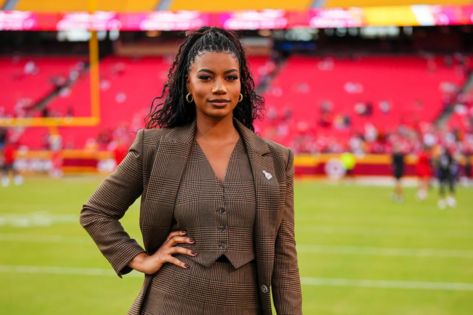In the weird, locked-down summer of 2020, while the world was stuck indoors trying to figure out sourdough starters and surviving Zoom fatigue, the NBA launched a surreal experiment by isolating its entire ecosystem inside the Walt Disney World Resort in Florida to finish the season. It was a Hail Mary for basketball, but for those inside, it became something more.
For players, it was a psychological pressure cooker. For journalists, it was a rare opportunity. It became a nature of drama, competition, and, for a few, transformation. For Taylor Rooks, it was all the above. And no, not in the meme-worthy “I survived the bubble” kind of way. For Rooks, the NBA bubble was a defining moment.
Rooks wasn’t just another media name assigned to the NBA bubble. She was part of a handpicked few, one of the few Black women journalists granted entry, tasked with telling the story of a league playing through a pandemic, a racial reckoning, and unusual scrutiny. Not just for her career; this was a defining moment, but for what sports journalism could look like when access, storytelling, and trust collided in isolation.
Taylor Rooks Took Over the NBA Bubble, And We Didn’t Even See It Coming
“I think the bubble was different things for different people,” Rooks said during her appearance on The Underdog Lounge, hosted by Ex-NBA star Lou Williams and Spank Horton. “For me, the bubble felt like career-changing… Like, that was a big career move.” You could hear it in her voice. This wasn’t nostalgia. This was perspective. In the bubble, with drastically limited media and access being crucial, Taylor Rooks actively participated, and she sure did show out.
“There was such a finite number of media in there that, like, if you was in the bubble… we were checking your stuff every day,” she added. “It was the only way to know what was happening.” Translation? If you had a mic and a message in that ecosystem, you had the ears of the basketball world. Rooks knew it, and she capitalized. Through smart interviews, thoughtful questions, and a presence that felt both authentic and essential, she made the NBA’s most surreal season feel just a little more human for the fans stuck outside.
In a moment where access was power, Rooks dominated the conversation outside of it. Her interviews were often the only lens fans had into the mental and emotional state of the league’s stars. No distractions, no entourages, no press scrums. Just raw, focused conversations.
“Coming out of the bubble was when I got my first Emmy nomination,” she shared, almost like it still surprises her. It shouldn’t. The grind was visible. The results, undeniable. Her work didn’t just resonate with viewers. It got industry attention, too. That clarity, in both setting and storytelling, earned her an Emmy nomination soon after. But what made Rooks’ presence so vital wasn’t just her proximity to players. It was also the trust she cultivated in a space where vulnerability was rare.
But of course, this being The Underdog Lounge, things didn’t stay serious for long. Lou Williams cracked a grin: “She got an Emmy. I got a train.” From there, the conversation bent into the kind of inside-bubble banter you’d never hear during a postgame presser. Rooftop parties, segregated hotel campuses, and the sacred, unspoken media-player divide. Damn!
“I just asked you, did you hear about the rooftop party?” Spank threw in, poking fun. Taylor Rooks hadn’t. “No… I don’t think you [Lou] were in my—like, you know how there was three different [zones]… Were you in the Coronado?”
Williams wasn’t. He was in “the main building,” home to the infamous rooftop. “They were over there losing money, playing bourré and spades,” Lou said, laughing. “You woulda stuck out like a sore thumb at the rooftop… We respected your space. Nobody even considered it, thought about it. Leave Taylor alone in this bubble.”
It’s a light moment, but it speaks volumes. In a hyper-masculine space like the NBA, especially one made even more intense by pandemic-era restrictions, Taylor Rooks earned more than visibility. She earned respect. The kind you can’t manufacture or PR your way into. There was no crossover between the rooftop gamblers and the media bar. And maybe that’s exactly why Taylor Rooks’ work stood out.
The NBA bubble was a litmus test for sports media. It exposed how reliant many networks are on controlled chaos—pregame soundbites, locker room access, sideline drama. Strip all that away, and what’s left? For some, not much. But for journalists like Rooks, it revealed something else: the power of presence. Of asking the right questions. Of showing up consistently and listening, even when the story is murky.
Rooks wasn’t chasing chaos or trying to blend in. She was showing up with intention, doing the kind of grounded, people-first journalism that hits harder when the world feels upside down. “I loved the bubble,” she said. “Yeah. It was great.”
Not exactly the narrative we usually hear about that stretch of time. Most people remember the NBA bubble for its eeriness—empty stands, squeaky sneakers, the ever-present threat of COVID tests. But Taylor Rooks’ view reframes the experience: What happens when you take a disruptive moment and use it as a launchpad?
Her bubble story is less about the games and more about the gaps. The space she filled. The presence she commanded. And the trust she earned, both from players and viewers watching through glass screens. It’s easy to look back on 2020 and want to forget. But Rooks? She made it unforgettable, for all the right reasons, of course.
The post Ex-NBA Star Exclaims as Taylor Rooks’ Career Alerting Incident Reveals Lesser Known Story of NBA Bubble appeared first on EssentiallySports.
